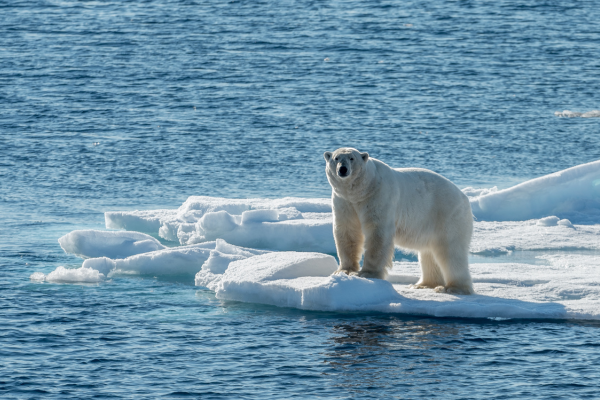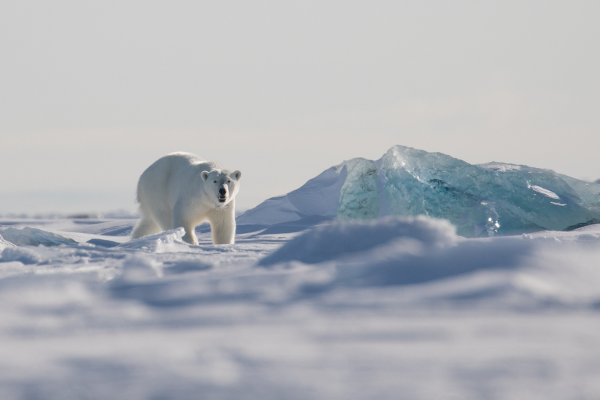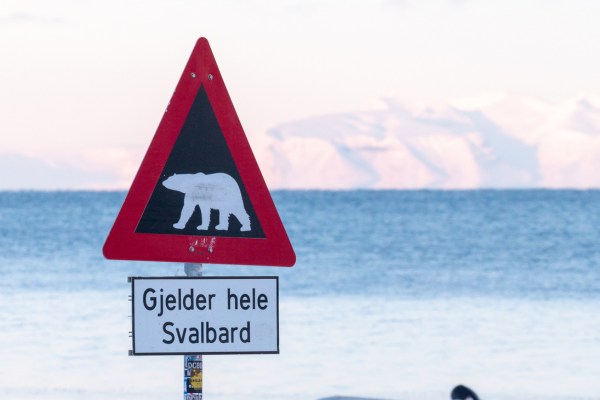NORWAY
Friends or Froze?
By Jenny McGlone
Chapel Hill, NC, United States
Midway between the North Pole and Norway, on the islands of Svalbard, a tale of coexistence unfolds between polar bears and the people who call this frosty wonderland home. Drawn by the opportunity to immerse themselves in a remote Arctic experience, Svalbard’s 2,700 human residents are undeterred by its extreme climate and icy wilderness.
Within the frozen landscape, polar bears reign as the largest land predators on Earth. An adult male polar bear can weigh as much as 1,300 pounds (600 kilograms) and stand on its hind legs up to 10 feet (3 meters) tall.
Bear in Mind
Scientists estimate that around 300 polar bears roam Svalbard’s vast 23,570 square miles (61,450 square kilometers). With roughly 60 percent of the archipelago covered in glaciers, it offers a refuge for these creatures, providing vital hunting grounds and a sanctuary for their survival.
Polar bears are naturally curious, and they have adapted to a barren environment by investigating anything that might be a food source. Encounters with humans may occur when polar bears venture near settlements or research stations in search of a meal, driven by their remarkable sense of smell and instinct to survive.
Polar Opposites
Local regulations carefully manage the relationship between humans and polar bears in Svalbard to ensure safety on both sides. By law, people venturing outside town limits carry firearms and flare guns to deter potential run-ins. They discharge rifles to create noise. This precautionary measure reduces the likelihood of conflict. Shooting a polar bear is legal only in cases of imminent danger.
A polar bear’s diet includes birds, fish, and whales, but they prefer seals. Sea ice provides them with excellent platforms to seek their favorite prey. With climate change, however, polar bears spend more time on shore, where they are more likely to cross paths with a human. A 2017 report found that 61 percent of attacks occur when a polar bear is malnourished.

Arctic Tactics
In addition to carrying deterrents, Svalbard residents use a variety of other strategies to stay safe. When camping, for example, they set up trip wires and take turns keeping watch during the night. At home, they leave their doors unlocked in case they have to make a quick getaway. Drivers often park their snowmobiles with keys in the ignition so they can retreat swiftly.
As habitat loss throws people and polar bears together, researchers will be studying how to mitigate danger to both populations. Respectful stewardship can foster a shared future that benefits humans and protects the remarkable creatures on our planet.
Have a suggestion for this story? We’d love for you to submit it!


Blank
Blank
Slideshow
Are you a teacher who’s interested in telling this story to your students? Here are slideshows you can use to get started.
Math Resources
- If Svalbard’s total land area is approximately 23,570 square miles, and 60 percent of it is covered in glaciers, what is the approximate area of the glacier-covered region in square miles? What is the area in square kilometers that is not covered by glaciers?
- Compare your size to a polar bear. If a polar bear weighs 1,300 pounds, how many of you would it take to equal that weight? How many of you would it take to equal a polar bear’s 10-foot height?
- Using the numbers provided by the story, find the ratio of humans to polar bears in Svalbard.
- During prime hunting season in the spring, polar bears need 12,000 calories each day to stay healthy. A seal’s blubber has 870 calories per 100 grams. How many grams of blubber does a polar bear need to eat in a day?
- The length of a trip wire used by Svalbard residents when camping is 20 meters. If trip wires are set up along the perimeter of the campsite, how many are needed to enclose a rectangular campsite that measures 400 meters by 200 meters?
Social Justice Question
How can we strike a balance between the economic benefits of tourism in Svalbard, which brings in much-needed revenue, and the potential negative impact it may have on the fragile Arctic environment? Can you think of any practices that can be implemented to ensure responsible tourism? What can the Norwegian government do to preserve the unique ecosystems and wildlife that make Svalbard a remarkable destination?
Explore Further
- More information about polar bears in Svalbard
- Analysis of polar bear attacks
- Example of climate change’s impact on Svalbard glacier
- Map with nationalities of Svalbard residents
- Website of the Global Seed Vault in Svalbard
Share Your Story
Write your own Global Math Story and send it to us!
Sorry, the comment form is closed at this time.